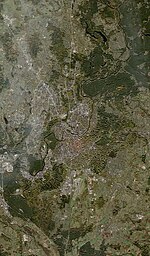Vilnius urban area
 From Wikipedia - Reading time: 5 min
From Wikipedia - Reading time: 5 min
Vilnius urban area
Vilniaus aglomeracija | |
|---|---|
Urban area | |
| |
 Vilnius City (orange) and District (green) Municipalities | |
| Country | |
| Largest city | Vilnius |
| Area | |
| • Urban | 2,529 km2 (976 sq mi) |
| Population (2023)[1] | |
| • Urban | 747,864 |
| GDP | |
| • Metro | €29.4 billion (2022) |
| Time zone | UTC+2 (EET) |

The Vilnius urban area (known in Lithuanian as: Vilniaus aglomeracija) is the urban area of Vilnius. The urban area covers several municipalities in the Vilnius County, with a total built-up area of around 350 km2.[3][4][5]
Demographics
[edit]The largest cities or towns within the urban area are Vilnius, Lentvaris, Grigiškės, Trakai, Nemenčinė, Rudamina, Pagiriai and Skaidiškės.
| Subdivision | Area (km2) | Population[6] |
|---|---|---|
| 400 | 602,430 | |
| 2129 | 106,197 | |
| 1208 | 32,546 |
Definition
[edit]While Vilnius urban area occupies only most of Vilnius City and Vilnius District municipalities and a small part of Trakai District, Vilnius metropolitan region is a larger entity, occupying, depending on definition, most or all of Vilnius county,[7] at some cases, stretching also well into Alytus and Utena counties.[8]
Dual-City (Dipolis)
[edit]Dual city of Vilnius and Kaunas (known in Lithuanian as: Vilniaus ir Kauno dvimiestis or dipolis) is an idea to combine resources of Vilnius and Kaunas to be able to compete with larger European cities like Warsaw, Budapest, Bucharest or Prague for Western investments. The plan, which includes various forms of collaboration and vocalizes the idea, among all the other projects,– of fast commuting between the two (most notably – the construction of high speed rail) is not fully realized but idea is slowly being implemented (see: Rail Baltica) and is brought up by politicians every year. Combined metropolitan area of both cities would have population of more than 1.0 million and would produce more than a half of Lithuania's total GDP.[9][10][11][12]
Economy
[edit]In 2022 Vilnius gross metropolitan product was almost €30 billion. This puts Vilnius in 80th place among cities in European Union.
Gallery
[edit]-
Yellow dotted line defines approximate borders of Vilnius urban area, while green colour shows municipalities which have territory in urban area. Grey shows rest of municipalities in Vilnius County
-
Limits of Vilnius city functional region according to intensity of traffic of daily commuters (the data of Lithuanian Road Administration under the Ministry of Transport and Communications)
-
Vilnius city bus in Lentvaris
-
Lentvaris railway station. Commuting from the town to Vilnius is widespread by rail, cars as well as some bus routes of Vilnius municipal buses run through Lentvaris.
-
New multi-storey housing is being built outside Vilnius like this residential house in Grigiškės
-
Some Vilnius city bus routes run through Grigiškės, Lentvaris, Klevinė, Bendoriai, Didžioji Riešė and other suburbs in Vilnius district and Trakai district municipalities
-
Zujūnai, one of suburbs of Vilnius
-
Suburban housing in Didžioji Riešė, an example of urban sprawl
-
Klevinė village where the number of inhabitants grew from just 11 in 2001 to 931 in 2021
-
Rows of suburban housing outside Vilnius in Vilnius district municipality
-
New housing some 6-7 km. to the north of the city border of Vilnius
See also
[edit]References
[edit]- ^ "Eurostat". eurostat.ec.europa.eu.
- ^ "Gross domestic product (GDP) at current market prices by metropolitan regions". ec.europa.eu.
- ^ "Urban Sprawl of Major Cities in the Baltic States", www.researchgate.net
- ^ "The sprawl of Vilnius city – establishment and analysis of growing urban region", www.researchgate.net
- ^ "Visual scheme of Vilnius urban area", www.researchgate.net
- ^ "Resident population on 1 January". osp.stat.gov.lt. 2024-01-22.
- ^ "OECD REGIONS AND CITIES AT A GLANCE - COUNTRY NOTE LITHUANIA" (PDF), www.oecd.org
- ^ "Metropolinių Lietuvos miestų migraciniai regionai XXI amžiaus pradžioje", www.lituanistika.lt
- ^ "Vilniaus-Kauno didmiesčio projektas vėl kaitina aistras: paaiškino, ką mano apie idėją", www.lrytas.lt
- ^ "Kauno ir Vilniaus dvimiestis: vizija ar netolima ateitis?", www.sa.lt
- ^ "VILNIAUS IR KAUNO DVIMIESTIS ATNAUJINO STRATEGINIO PLANAVIMO KOMISIJĄ", www.pilotas.lt
- ^ "Gaivinama Vilniaus ir Kauno dvimiesčio idėja", www.tv3.lt
 KSF
KSF















